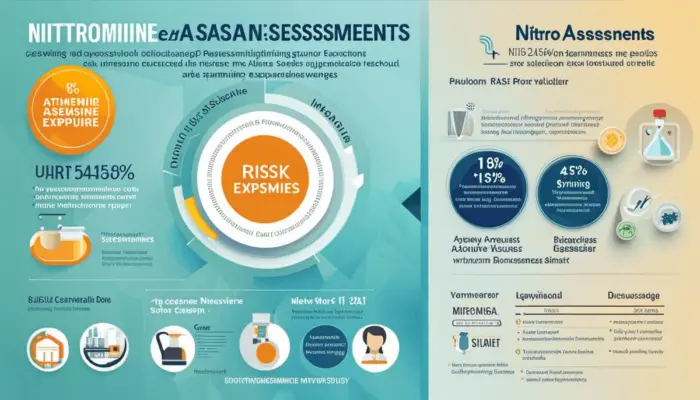In an ever-evolving scientific landscape that requires rigorous investigation and constant vigilance, a substance called nitrosamines exists.
These ubiquitous compounds, found in various everyday items we consume, pose significant health issues that thrust them into the public consciousness.
Thus, understanding their nature, implications, and sources becomes a task of utmost importance.
In this context, this exploration aims to distinctly dissect nitrosamines, immerse in the process entailing their risk assessment, review current regulatory guidelines, draw upon real-world examples, and prognosticate future challenges and opportunities.
Understanding Nitrosamines
Nitrosamines are a type of chemical compound, most of which are known to be potentially carcinogenic.
They are usually produced when nitrites and amines react under certain conditions, particularly in acidic environments.
Nitrites are often used as food preservatives, especially in processed meats, while amines are typically found in proteins.
Notably, nitrosamines are not usually added directly to foods but form during cooking, digestion, or food processing.
Major Sources of Nitrosamines and Their Implications
Nitrosamines can be found in various sources, including food and drinks. Some major food sources include bacon, ham, sausages and other processed meats.
They can also be found in beer, cheese, fish, cosmetics, and tobacco products.
Regarding drinks, nitrosamines are often found in treated and untreated water supplies as they can form during water treatment processes or leach into groundwater from certain industrial operations.
The presence of nitrosamines from these sources necessitates robust methodology for their detection and risk assessment, primarily due to their high propensity for causing severe health impacts.
Consumption of nitrosamines has been linked to the development of various types of cancers, including liver, stomach, bladder, and esophageal cancer.
Nitrosamine Risk Assessment Overview
In nitrosamine risk assessment, a well-structured method is typically utilized. This key method is a three-phase approach, starting with identifying potential sources of nitrosamines, testing for their presence and concentration, and finally assessing the health risks associated with the level of exposure.
In the initial phase, it is crucial to profile and sample goods or products containing nitrosamines as the first step toward estimating their potential risk.
The second phase involves utilizing various analytical methods, such as chromatography and spectrometry, to verify nitrosamines’ presence and quantify their concentration in the samples.
The concluding phase considers the nitrosamines’ concentration, the route of exposure, and the duration of exposure, to calculate the associated risk.
This phase often relies on predictive modeling, toxicological studies, and epidemiological data to estimate potential health risks.
The goal of nitrosamines risk assessment is to calculate the health risks precisely and to lay a credible scientific foundation for decision-making and risk management, ultimately enabling the development of strategies to reduce exposure and manage risks.

Risk Assessment Process for Nitrosamines
Determining the Risks Associated with Nitrosamines
The first phase in nitrosamine risk assessment is the critical process of pinpointing the potential sources and identifying the risks linked to this class of carcinogenic compounds, known as nitrosamines.
These compounds could form in various industrial settings, most notably in manufacturing rubber, pesticides, cosmetics, and certain pharmaceuticals.
Nitrosamines can also be formed unintentionally in cured and cooked foods due to a reaction between nitrite and some amino acids.
Crucial risk factors to be considered in this phase include identifying sources of exposure, the length of exposure, the existence of factors that may accelerate nitrosamine formation, and understanding the likely health effects in the context of the exposed population.
Risk Analysis of Nitrosamines
In the risk analysis phase, a qualitative or quantitative assessment of the likelihood and magnitude of harmful effects in a given population due to exposure to nitrosamines is conducted. Various tools and techniques are employed for nitrosamine risk analysis.
These include laboratory testing methods for quantifying nitrosamines in different matrices, toxicological analysis for determining the dose-response relationships of nitrosamines, and computational models for estimating risk based on exposure and dose-response information.
Risk Evaluation for Nitrosamines
The risk evaluation stage involves summarizing and integrating information from the risk identification and analysis stages.
It includes determining whether the estimated risk is acceptable and what options are available for risk management. The nitrosamine risk evaluation must also consider the uncertainties and limitations in the data and methods used.
Nitrosamine Risk Assessment Methodologies
Performing risk assessments for nitrosamines requires careful selection and application of appropriate methodologies.
Screening-level risk assessments can be used to prioritize nitrosamines based on their potential for exposure and adverse health effects.
Detailed quantitative risk assessments can then be conducted on the prioritized nitrosamines to estimate their cancer risks in the population.
Nitrosamine Risk Assessment Tools and Techniques
Several tools are available for nitrosamine risk assessment. These include laboratory analytical methods, such as Liquid Chromatography-Mass Spectrometry (LC-MS), for detecting and quantifying nitrosamines, methods for assessing dietary and environmental exposure to nitrosamines, and methods for evaluating their toxicological effects.
Statistical and computational models can integrate exposure and toxicological data into risk estimates.
Taking Action Based on the Nitrosamine Risk Assessment
Post-risk assessment, viable actions could involve changes to production processes to reduce potential nitrosamine formation, implementation of additional controls and protective measures, or changes to existing regulations and guidelines to limit nitrosamine exposure.
Constant monitoring and periodic re-assessments are crucial as scientific understanding and industry practices evolve and new data becomes available.
An Introduction to the Nitrosamine Risk Assessment Template
Implementing a nitrosamine risk assessment template effectively involves complete incorporation of risk assessment phases, such as identifying the risks and assessing and evaluating them.
The template should be designed to specify the tools, methodologies, and techniques required during each stage, maintaining a flexible approach to adapt to new methodologies, techniques and data as they emerge.
The ultimate aim is to achieve a comprehensive and accurate assessment of nitrosamine risk to support informed decisions for risk management in the industry.

Regulatory Guidelines on Nitrosamines
Comprehending the Concept of Nitrosamines
Nitrosamines belong to the class of chemical compounds known for their carcinogenic properties. Their formation can occur in many ways, including high-temperature cooking or during the interaction between nitrite preservatives in meats and amino acids.
Particularly in the pharmaceutical industry, nitrosamines have drawn much attention, as their formation could occur during the production and storage of drugs, posing a potential safety risk to patients.
Regulatory Agencies Concerning Nitrosamines
Various organizations regulate nitrosamine levels, with the main ones being the United States Food and Drug Administration (FDA), the European Medicines Agency (EMA), and the World Health Organization (WHO).
These agencies have specific guidelines for the prevention, detection, and control of nitrosamines.
FDA’s Stance on Nitrosamines
In the United States, the FDA has set standards on the permissible levels of nitrosamines in various products, including drugs and cosmetics.
The FDA provides guidelines on the control strategies for limiting nitrosamine impurities.
It has implemented a risk assessment approach, including evaluating the product’s nitrosamine content, manufacturing process, and proposed usage.
EMA on Nitrosamines
In Europe, the EMA has set specific acceptable intake levels for particular nitrosamines, such as N-nitroso dimethylamine (NDMA) and N-nitroso diethylamine (NDEA).
Estimating the potential cancer risk associated with exposure to these substances determines the limits.
World Health Organization Guidance
WHO has published guidance for nitrosamines risk assessment. This guide provides a detailed explanation of how to assess the risk posed by nitrosamines in pharmaceuticals and how to mitigate those risks.
Risk Assessment Template For Nitrosamines
A typical risk assessment template for nitrosamines involves several steps. First, there’s the determination of the potential sources of nitrosamines.
The next step is evaluating the risk of nitrosamines being present, followed by developing and implementing a control strategy.
A quantitative risk assessment may be done if the risk is considered high. The risk assessment must include the production process, raw and starting materials, and reaction conditions.
The nitrosamine risk assessment template must also be integrated and continuous, becoming part of the overall quality risk management process.
This requires regular review and updates of the assessment throughout the product lifecycle.
Mitigation Strategies for Nitrosamines
Nitrosamine mitigation strategies largely depend on the severity of the risk identified in the assessment.
This can range from minor adjustments to the manufacturing process or storage conditions to substantial changes in the chemicals used in production. Other mitigation methods include regulatory actions such as recalls or use restrictions.
Conclusion
Navigating safely through nitrosamines necessitates a thorough understanding and implementation of the guidelines set by relevant health authorities.
The key lies in creating and employing a comprehensive nitrosamine risk assessment template, which is adept at evaluating, managing, and mitigating any associated risks.
Adhering to this regulatory framework safeguards the quality of pharmaceutical products, ensuring they are safe for patient consumption.
This not only prevents avoidable harm but also confirms regulatory compliance.

Case Studies on Nitrosamine Risk Assessment
Case Study: The Nitrosamine Controversy in Valsartan Medications
Nitrosamine impurities in sartan-based blood pressure medications caused an international stir in 2018, leading to worldwide recalls.
One drug implicated was Valsartan, which was found to contain N-nitroso dimethylamine (NDMA) and N-nitroso diethylamine (NDEA), both acknowledged as potent carcinogens.
This inadvertent inclusion of hazardous substances originated from a change in manufacturing protocols at Zhejiang Huahai Pharmaceuticals in China, the firm producing Valsartan.
The risk assessment of this shocking incident revealed that the pharmaceutical company had transitioned to a cost-effective and environment-friendly manufacturing method.
Unfortunately, they disregarded a thorough quantitative risk assessment, resulting in an unanticipated increase in nitrosamine impurities.
The incidents’ aftermath included the recall of affected batches and the enactment of stricter regulatory mandates to scrutinize and manage nitrosamine risks in all pharmaceutical preparations.
Diethylhexyl Nitrosamine (DEN) in Rubber Industry: A Case Study
The rubber industry heavily uses nitrosamine for vulcanization agents. However, nitrosamines such as Diethylhexyl nitrosamine (DEN) are known to be potent carcinogens.
A risk assessment in an unnamed rubber production facility showcased the extensive use of DEN as unintended byproducts.
After the risk assessment, comprehensive preventive strategies were implemented, which included using nitrosamine-free accelerators to reduce worker exposure and eliminate nitrosamine releases into the environment.
A continuous monitoring system was also introduced to test and detect nitrosamine levels in products regularly.
The case demonstrated the importance of conducting thorough risk assessments and applying preventive measures when dealing with hazardous substances like nitrosamines.
Nitrosamines in Processed Meats – Case Study
Nitrosamines, particularly NDMA and NDEA, have also been found in processed meats due to using sodium nitrite as a preservative, which reacts with secondary amines to form these compounds under certain conditions.
A risk assessment for this industry highlighted the need for controls on sodium nitrite levels and monitoring of nitrosamine levels.
The results led to the meat industry employing several preventive measures like natural antioxidants, like tocopherols and ascorbic acid, which inhibit nitrosamine formation.
They also began using nitrite-free curing agents and instituted best handling practices in meat processing to minimize nitrosamine formation.
Conclusion
Evaluating the presence of nitrosamines across various industries bolsters the significance of risk assessments.
Undeniably, any unchecked exposure to nitrosamines can yield serious health issues. Hence, the necessity for risk assessments becomes evident.
These assessments are primary tools to identify potential threats and recommend corrective and preventative action to reduce nitrosamine exposure.
Employing the nitrosamine risk assessment template is an uncomplicated and efficient means of carrying out these evaluations, thereby ensuring the safeguarding of public health.

Future Challenges and Opportunities in Nitrosamine Risk Assessment
The Contemporary Perspective on Nitrosamines
Nitrosamines constitute a group of organic compounds infamous for their carcinogenic attributes, with a significant portion, termed uncertain or potential carcinogens in humans.
These compounds infiltrate numerous aspects of human lives, permeating artificial and natural mediums such as food, beverages, cosmetics, and pharmaceuticals.
They also exist as undesirable byproducts of industrial activities, water sanitation processes, tobacco consumption, and even in gastric juices following the ingestion of food preserved with nitrites.
Any surge in nitrosamine levels or exposure culminates severe health repercussions, including cancer and liver and lung diseases.
Current Practice in Nitrosamine Risk Assessment
Risk assessment for nitrosamines primarily involves data collection and analysis of nitrosamine levels in different matrices, identification of exposure sources, review of toxicological data, and performing risk analysis based on established exposure and toxicity thresholds.
Current methods of quantifying nitrosamines involve spectroscopic, chromatographic, and mass spectrometric techniques.
Future Challenges in Nitrosamine Risk Assessment
Future challenges in nitrosamine risk assessment will likely be driven by emerging nitrosamine sources, evolving regulatory standards, and technological advancements in analytical and computational methods.
One major challenge is the continual identification and evaluation of new nitrosamine compounds since studies have shown that nitrosamines can form under various conditions in manufacturing and through misuse of products.
This can prove difficult due to the reactive nature of nitrosamines and the complexity of validating analytical methods suitable for all varieties.
As nitrosamine testing becomes more widespread, establishing reliable and standardized protocols for testing, reported data interpretation, and risk assessment is another challenge.
New regulatory requirements also challenge testing facilities and necessitate new analytical equipment and training investments.
Opportunities in Nitrosamine Risk Assessment
Despite the challenges, the evolving landscape of nitrosamine risk assessment offers multiple opportunities to enhance the accuracy, reliability, and relevance of risk assessments.
Emerging technologies in analytics and big data present an opportunity for improved screening and detection of nitrosamines.
Machine learning and artificial intelligence could predict the presence and risks of nitrosamines in various matrices using datasets derived from ongoing monitoring efforts.
Another opportunity is integrating in vitro and in vivo toxicological data with human epidemiological data to create more substantive risk assessment models.
Recommendations for Continued Improvement
Industry experts must stay updated on emerging nitrosamine sources, detection techniques, and regulatory standards.
It’s also essential to be involved in international collaborations and information exchanges to influence policy and improve nitrosamine risk assessment globally.
Moreover, investment in research and development and continuous staff training can enhance analytical capacity.
Finally, developing robust risk communication strategies is crucial to convey nitrosamine risk information to the public, regulators and other stakeholders.

Thus, as we advance in the exploration and study of this potent compound, our collective cognizance must also evolve accordingly.
Throughout this examination of nitrosamines, we have seen their potential implications, the rigorous process of assessing the risk they impose, regulatory guidelines that govern their levels, real-world instances of their assessment, and future challenges.
The arena of nitrosamine risk assessment, although challenging, brings along opportunities for growth, learning, and advancement.
This endeavor to examine nitrosamines from all possible angles aims to inspire the development of more comprehensive methodologies, plus the effective implementation of corrective and preventive measures.
As we stand on the precipice of future expansions in this field, enduring focus and sustaining growth will be the true hallmark of our success.

Chris Ekai is a Risk Management expert with over 10 years of experience in the field. He has a Master’s(MSc) degree in Risk Management from University of Portsmouth and is a CPA and Finance professional. He currently works as a Content Manager at Risk Publishing, writing about Enterprise Risk Management, Business Continuity Management and Project Management.

